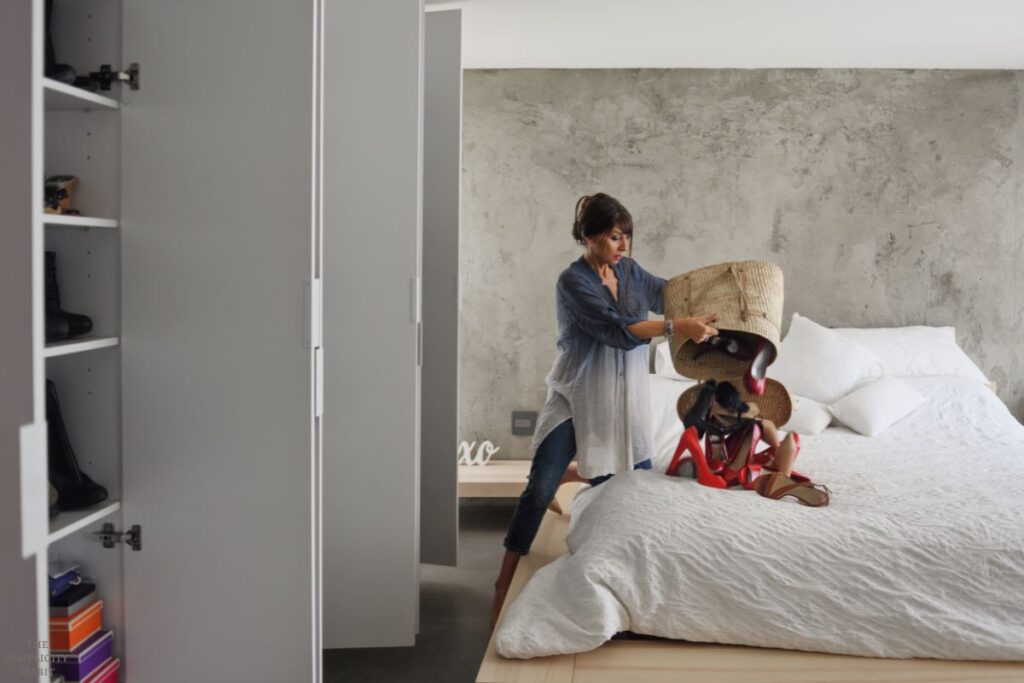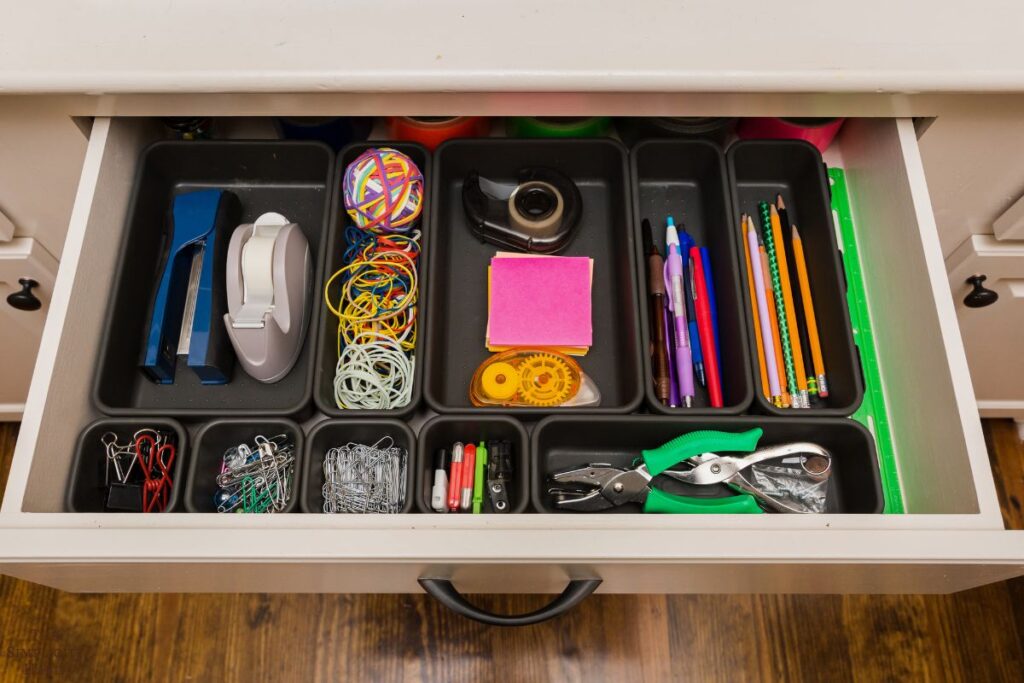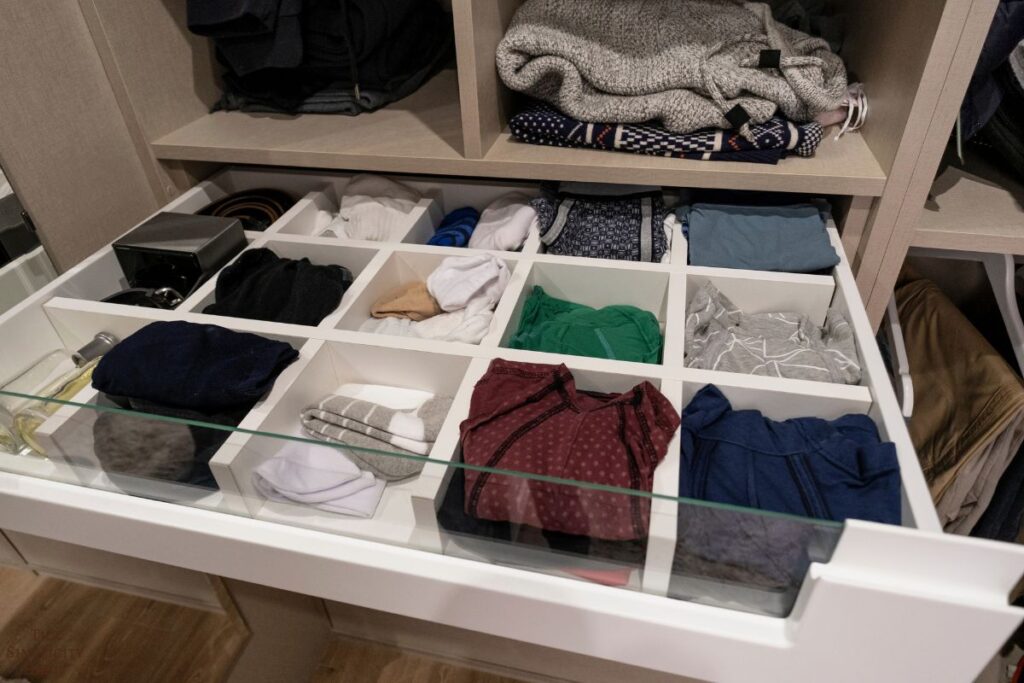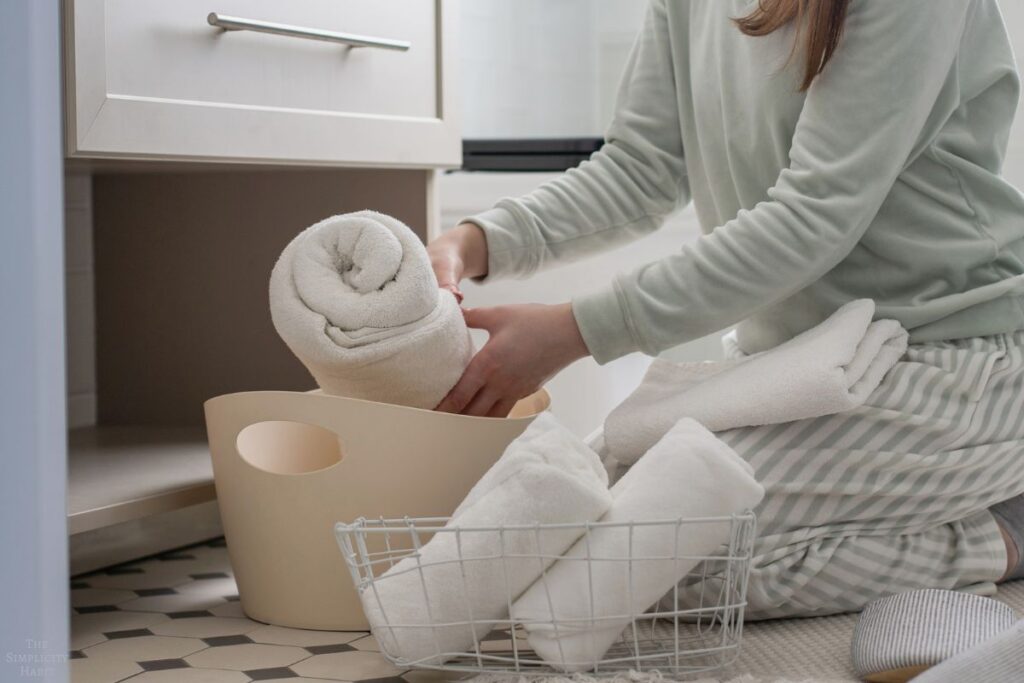Inside: Use these helpful tips for removing the hidden clutter lurking behind closed doors and inside drawers.
Even if your home appears decluttered, there’s a chance you may have clutter hiding in places that aren’t immediately visible.
But what about your hidden clutter – the clutter that gathers behind closed doors and drawers?
Many of us embrace the “out of sight, out of mind” philosophy and simply pretend it isn’t there.
After all, it’s easy to act like it doesn’t exist when it isn’t constantly staring you in the face. But there’s no getting around it – it is there, waiting to greet you anytime you need to find something in that cupboard, closet, or drawer.
If you open doors or drawers and they’re overflowing with stuff, odds are that hidden clutter has become a problem.
If you’re ready to roll up your sleeves and deal with the clutter lurking behind closed doors, I’ve got you covered.
Keep reading for some helpful tips and actionable steps you can take to get rid of that hidden clutter and keep it from coming back.

Tips for Removing Hidden Clutter
The thought of addressing your hidden clutter can be a little overwhelming – because in many cases, it’s hard to know how bad the problem actually is until you dive in and begin the process.
But with a little effort, some elbow grease, and a plan of attack, you can be sure that your hidden clutter will be gone for good.
1. Get that hidden clutter out into the open.
The first thing you need to do when decluttering behind closed doors?
Get that stuff out of those closed doors and into the open.
I recommend focusing on one drawer, closet, or cupboard at a time – instead of doing it all at once. It will make the decluttering process easier by making it less overwhelming and more doable. The pace at which you choose to tackle it is up to you based on your time and energy.
Pick a place to start, then begin the process of clearing it out. Don’t just pile everything up – lay it out in a manner that lets you see what you’ve been storing inside. You need to be able to assess what’s actually in there.
And while you’re at it? Take advantage of this opportunity to give those spaces a good cleaning. Chances are, they’ve accumulated a bit of dust since the last time they were empty. There’s no better time than now to clear it out!

2. Get rid of any clutter that’s obvious trash – and donate what you don’t need to keep.
Now that you’ve gotten your clutter out where you can see it, it’s time to evaluate everything that was taking up space to see if you actually need it.
You might be surprised to find in many cases, the answer is no. And it makes sense. After all, if it’s been lurking unused in a closet or drawer for months, if not years, why would you suddenly need it now?
There are a few things you need to do as part of this step:
Identify and dispose of any actual trash.
If something no longer serves you – and can’t benefit anyone else – chances are it belongs in the garbage. Of course, recycle when you can!
Determine what can be donated.
If you’ve got stuff that you don’t think you’ll use again but others may benefit from, now’s the perfect time to set it aside to donate. Clothes, kitchenware, books, and all kinds of things in good condition will be much appreciated by those in need.
Figure out what you need to keep – and where it belongs.
Chances are, some of the stuff you pulled out of that hidden space does need to stick around. But does it need to go back into that specific drawer or closet? Is there a better place for it? If there is, set it aside and ensure it goes where it belongs – not back into the same old space.

3. Set a clear purpose or theme for each drawer, cupboard, or closet.
In an ideal situation, you have enough drawers and closets to accommodate everything you need to keep. If you don’t, consider whether the problem is truly not enough space or just too much stuff.
Your silverware drawer doesn’t need to double as your kitchen junk drawer, and the coats and shoes you wear on a regular basis shouldn’t be stored in the same closet as the linens you reserve for your guests.
By clearly defining what belongs in which space, you can make it easier for yourself and your family to know where things go.
You may even want to invest in a label maker – or if you’re creative, DIY some on your own – to make it crystal clear what goes where, down to the specific shelf.

4. Use organizational systems to keep your closets, drawers, and cabinets clutter-free.
Once you’ve had a chance to narrow down the stuff you want to keep and identify where it all belongs, it’s time to put everything back.
But that doesn’t mean you should haphazardly shove it all back into closets and drawers – even if you’re tired of decluttering and just want to be done with the process.
Instead, it’s time to be intentional about what goes where – and how it goes back into those hidden spaces. Create an organizational system that works for you and your home.
In many cases, you’ll benefit from investing in a few select tools to keep those closets, cabinets, cupboards, pantries, and drawers tidy and organized. Drawer dividers can be a tremendous help when you’re storing away things like silverware, craft supplies, or even clothes.
Hanging organizers can make a massive difference when trying to maximize space and organization in small closets. And baskets and bins that fit neatly on shelves can be really helpful when it comes to making the most of your cabinets, or any space with shelving.

5. Revisit the spaces where hidden clutter accumulates on a regular basis to keep things under control.
Despite your best efforts and the best baskets, hooks, bins, and drawer dividers, clutter can still accumulate if you aren’t careful – or mindful. Certain areas in the home tend to become clutter hotspots.
That’s why it’s important to stay on top of the situation moving forward by regularly examining those hidden clutter areas to ensure things are still the way you want them.
It’s a lot easier to make decluttering a habit than to wait until the problem has reached the point of no return.
By peeking into those drawers and shelves with intention each month, or once a quarter, to make sure things are still organized the way you want them, you can get ahead of clutter before it starts.
You might find, over time, that the storage solutions you thought would work need a little adjustment. By refining as you go and addressing clutter before it has a chance to build back up, you’ll save yourself the headache of undertaking this project again.

What is your strategy for removing hidden clutter? Leave a comment and let me know what works for you!
Did areas with hidden clutter in your home cross your mind as you read this article? Now is a great opportunity to get the space under control.
You don’t have to continue to dread opening certain doors and drawers in your home. Create a more peaceful and organized home by decluttering not only the obvious spaces but the hidden ones too.
Sign up on the form below to get weekly decluttering tips and inspiration sent straight to your inbox. You’ll also get the free 5 Areas to Declutter in 10 Minutes Checklist to help you get started decluttering today.


My biggest area of clutter is all the baby things I have accumulated over the past 4 1/2 years. I have been babysitting my special needs granddaughter since birth and I am looking forward to next fall when she begins kindergarten full time. My house doesn’t have much storage and all the baby things have taken over extra closets, underneath beds, old dressers, and her room. I don’t necessarily want to get rid of much because some day I hope to have more grandkids. BUT……..my other two children aren’t dating right now and who knows if they’ll ever find that special someone. How do you downsize the baby things without starting over? The baby things are a great source of anxiety for me and I know I need to let go of a lot of it.
I need to declutter our house your hints are extremely helpful.
I finally got my closets cleaned out. My process after cleaning was to stack all the clothing I did not need anymore in a bedroom then my daughter went through and took what she wanted, the granddaughter took only the larger t-shirts, the future granddaughter-in-law took what she wanted and the remainder (still quite a bit) will be taken to the neighbor so that her three daughters-in-law (all taller and slimmer than I am) can hopefully find things they can use. Any items remaining will either be passed on to their friends or donated. I guess that’s called quadruple or perhaps quintuple recycling? At any rate my closets are clean and more spacious and nothing has been wasted so that’s a win for everyone! I enjoy your articles and find them helpful.
No hidden clutter here in my home, but I have a rule I share with my clients. Rule: One in one out! If you buy something new (clothing and/or linens specifically), when you put it away in your closet or drawer, you have to donate something old out of that closet or drawer.
I am so sentimental. it is hard to part with things with memories. My family says Memories are in the head not in possessions.I may have to downsize because of mobility- I do not want a stair lift/chair. would rather have a bungalow or ground floor apartment.
Hurrah for Gloria! You are enjoying clutter-free storage but not at the cost of burdening the landfill with excess stuff. I would like to add that sometimes sharing like this can meet a real but unspoken need for another family. Your comment made my day.–Anne
l agree with comments about invisible clutter. The clutter I need to eliminate include apps and regrets regarding previous decisions.